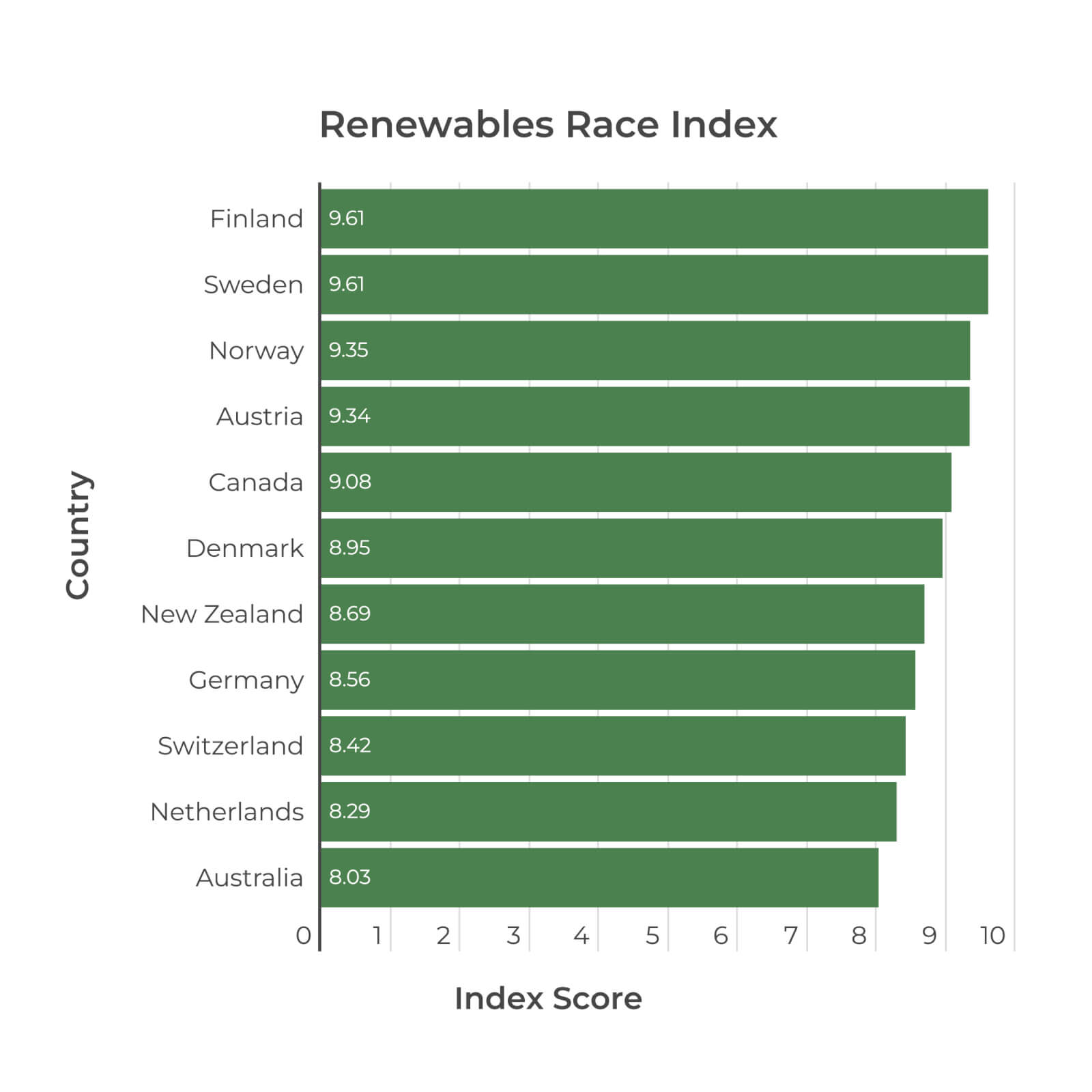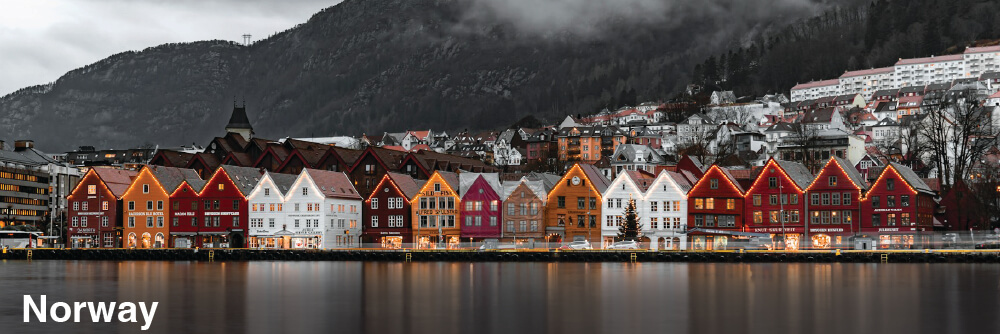The Burrow

As most countries pledge to reach net zero emissions in the next three decades, switching to renewable energy is key to limit each nation’s carbon footprint.
About 60 per cent of greenhouse gas emissions come from the United States, European Union, China, India, and Russia as at 2021.1
However, not every country is as ambitious and quick to make the transition.
As experts in helping Australians compare energy plans, we studied which nations will generate the largest amount of renewable energy based on the projected local population by 2028 – according to forecasting by the International Energy Agency (IEA) and Organisation for Economic Co-operation and Development (OECD).
Additionally, we also analysed the net zero emissions targets of each country to form the renewables race index.
While each country will generate varying amounts of renewable energy depending on local demands and environmental conditions, this story foregrounds which nations are expected to produce more green electricity per capita.

The 10 best-ranking countries in the renewable race index included:

Finland and Sweden were named the most ambitious countries in the renewables race index.
Finland is forecasted to generate 11.05 terawatt hours (TWh) of renewable energy per million people by 2028, according to the IEA.
The Baltic nation will produce 62.3TWh of green electricity in total for a population of about 5.6 million people in 2028, which represents a 62.4% improvement compared to 2000.
Meanwhile, Sweden is projected to produce 13.57TWh in renewables for every million people by 2028.
The Scandinavian country is forecasted to generate 146.8TWh for about 10.8 million people in 2028, which is a 43.4% improvement compared to the green energy production levels in 2000.
Both European nations had more ambitious legislated targets to reach net zero emissions, with Finland being ahead of Sweden – set to the years 2035 and 2045 respectively – resulting in an identical renewables race index score.

Norway was second-best in the renewables race index.
The Scandinavian nation is expected to produce 29.90TWh of renewable electricity per million people by 2028.
It will generate 168.1TWh in total for a population of about 5.6 million in 2028, which marks an increase of 26.3TWh (15.6%) on top of an already high mark in 2000.
Norway has promised, in law, to be net zero emissions by 2050.

Austria was ranked the third-most progressive country for renewable energy.
The European nation is anticipated to generate 7.61TWh of green electricity per million people by 2028.
In total, it will supply 70.7TWh of renewables for about 9.2 million people in 2028, which represents a 27.4TWh (38.8%) improvement compared to 2000 levels.
Austria has committed to be net zero emissions by 2040.

Mexico was named the least progressive country in the renewables race index.
The North American nation is only forecasted to generate 0.73TWh of renewable energy per million people by 2028, according to the IEA.
It is projected to produce 99.4TWh of renewables in total for a population of 64.7 million in 2028, which represents a 58.7TWh (59.1%) improvement compared to 2000 levels.
Mexico has not pledged any target to be net zero emissions – and therefore ranked at the bottom of the renewables race index.

Türkiye was ranked second last in the renewables race index.
The Middle Eastern country is anticipated to produce 2.48TWh of green electricity per million people by 2028.
It is forecast to generate 226.2TWh of renewables in total for around 91.1 million people in 2028, which is already a 195.3TWh (86.3%) boost compared to 2000.
However, Türkiye only plans to be net zero emissions by 2053, which contributed to its low ranking.

South Africa was the third least progressive country in the renewables race index.
The country is projected to only generate 0.83TWh in renewable energy per million people by 2028.
In total, this means 53.9TWh of green electricity is expected to be produced for about 64.7 million people in 2028, which does mark a 52.5TWh (97.4%) improvement compared to 2000 levels.
South Africa has pledged to be net zero emissions by 2050.
| Rank | Country | Forecasted 2028 Renewable Generation (TWh) |
| 1 | United States | 1,596.3 |
| 2 | Canada | 497.8 |
| 3 | Germany | 449.3 |
| 4 | Japan | 302.0 |
| 5 | United Kingdom | 238.3 |
| 6 | Türkiye | 226.2 |
| 7 | Spain | 222.0 |
| 8 | France | 199.9 |
| 9 | Norway | 168.1 |
| 10 | Italy | 163.6 |
Focusing on which countries are forecasted to generate the largest total amount of renewable energy sources in 2028, the United States topped the list with 1,596.3TWh – more than triple that of Canada, despite supplying less renewables per capita.
However, European nations continued to dominate with seven countries sitting in the top 10, including Germany, the UK and Türkiye.
Each country will generate varying amounts of renewable energy – depending on local population and electricity demands, public policies, infrastructure capabilities, and local environmental conditions.
Compare the Market’s Head of Energy, Meredith O’Brien, said as countries transition to be renewable energy powered, this could result in cheaper future electricity bills.
“Renewable energy is simply cheaper to produce than relying on the highly volatile prices of coal and gas, particularly from wind and solar infrastructure,” Ms O’Brien said.
“Amid cost-of-living pressures, households today can already be a step ahead of each country’s renewable energy transition strategies by installing solar and battery storage systems to save money and be more self-sustainable.
“However, there are still ways to save money for home owners and renters who are unable to install renewable infrastructure, including using smart plugs to adjust energy usage habits, and adopting more efficient LED lights and appliances.
“As renewable energy technology expands and improves, the investment costs are coming down which means you’ll reap from the savings even quicker.”
Data is accurate as of 31 May 2024.
We analysed the forecasted renewable energy generation of 39 countries in 2028, according to the International Energy Agency’s (IEA) Renewable Energy Progress Tracker.
To identify which nations will supply more renewable energy per million people, we synthesised the data with 2028 population projections by the Organisation for Economic Co-operation and Development (OECD).
Two metrics were used to form the overall renewables race index score and ranking (rounded to the nearest one decimal place), with a higher number representing a stronger performance:
The IEA classifies renewable energy sources as:
Additional sources:
| Rank | Country | 2028 Renewable Generation (TWh per million people) | Net Zero Target Year | Overall Index Score |
| 1 | Finland Sweden | 11.05 13.57 | 2035 2045 | 9.61 |
| 2 | Norway | 29.90 | 2050 | 9.35 |
| 3 | Austria | 7.61 | 2040 | 9.34 |
| 4 | Canada | 11.87 | 2050 | 9.08 |
| 5 | Denmark | 7.23 | 2045 | 8.95 |
| 6 | New Zealand | 7.38 | 2050 | 8.69 |
| 7 | Germany | 5.27 | 2045 | 8.56 |
| 8 | Switzerland | 5.91 | 2050 | 8.42 |
| 9 | Netherlands | 5.50 | 2050 | 8.29 |
| 10 | Australia | 4.79 | 2050 | 8.03 |
| 11 | Chile | 4.74 | 2050 | 7.90 |
| 12 | United States | 4.55 | 2050 | 7.77 |
| 13 | Estonia | 4.54 | 2050 | 7.63 |
| 14 | Spain | 4.53 | 2050 | 7.50 |
| 15 | Ireland | 4.49 | 2050 | 7.37 |
| 16 | Portugal | 4.29 | 2050 | 7.24 |
| 17 | Greece | 3.50 | 2050 | 7.11 |
| 18 | United Kingdom | 3.46 | 2050 | 6.98 |
| 19 | Belgium | 3.18 | 2050 | 6.85 |
| 20 | France | 2.89 | 2050 | 6.71 |
| 21 | Lithuania | 2.81 | 2050 | 6.58 |
| 22 | Italy | 2.78 | 2050 | 6.45 |
| 23 | Latvia | 2.63 | 2050 | 6.32 |
| 24 | Japan | 2.51 | 2050 | 6.19 |
| 25 | Costa Rica | 2.42 | 2050 | 5.92 |
| 26 | Poland | 2.17 | 2050 | 5.79 |
| 27 | Luxembourg | 1.93 | 2050 | 5.53 |
| 28 | Colombia | 1.51 | 2050 | 5.40 |
| 29 | South Korea | 1.41 | 2050 | 5.27 |
| 30 | Hungary | 1.36 | 2050 | 5.13 |
| 31 | Argentina | 1.33 | 2050 | 5.00 |
| 32 | Slovak Republic | 1.28 | 2050 | 4.87 |
| 33 | Czechia | 1.26 | 2050 | 4.74 |
| 34 | Singapore | 1.01 | 2050 | 4.61 |
| 35 | South Africa | 0.83 | 2050 | 4.48 |
| 36 | Türkiye | 2.48 | 2053 | 1.85 |
| 37 | Mexico | 0.73 | N/A | 0.00 |